In the previous post, we showed how to transform a typical relational data model to a graph data model and load it into a Kuzu database that could then be queried via Cypher to answer path-related questions about the data. The aim of this post is to show how Kuzu offers numerous tools that allow users to flexibly model and analyze data. We will analyze a transaction network, and use a combination of Cypher queries, graph visualization and network analysis to answer questions about the data.
Analyzing a transaction network
The dataset used in this post extends from the one used in the previous post and is an example of a network of clients, merchants and their transactions. It’s inspired by a similar dataset used in the book Graph Powered Machine Learning1.
In the real world, especially when credit card transactions are involved, it’s all too common to see cases of fraud. Certain transactions can be disputed by clients who have cause to believe that a transaction was unauthorized or fraudulent. In such cases, the client marks a transaction as disputed.
Relational schema
Imagine that you are an analyst tasked with investigating such a dataset. The most likely source of such a dataset would be a relational system, with a schema that looks something like this:
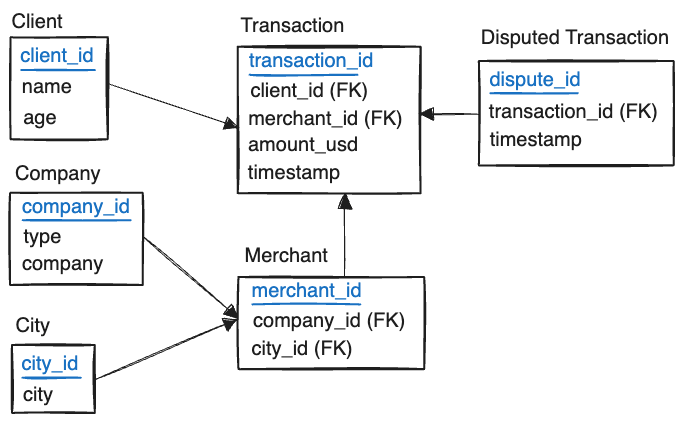
The primary table of interest is the transactions table, which contains records of all the
transactions made by a client with a particular merchant. A merchant is a store or a business that
provides goods or services. The disputes table contains records of all the disputed transactions,
marked after the fact and stored in a separate table.
When considering questions about disputed transactions, aggregation queries are not enough. We need to study the paths between the clients, merchants and transactions. This is where a graph database like Kuzu is very handy. The data model used by Kuzu is a structured property graph model, allowing us to capture the relationships between entities in a more natural way, for specific query workloads such as this one.
Graph schema
The following graph schema makes sense for our dataset:
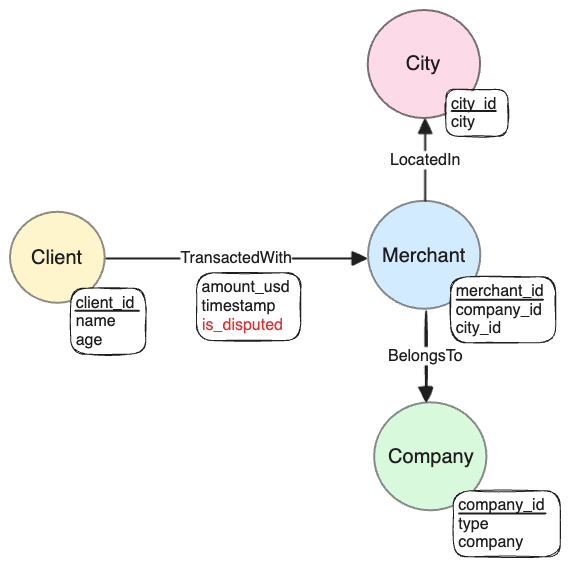
The transactions are modelled as edges, with an is_disputed property to indicate whether
a transaction is disputed or not. This simplifies the kinds of queries we need to write, and is
sufficient for our initial analysis.
Inserting data into Kuzu
The previous post went into the data transformation and ETL aspects, so we won’t go over that here. In a nutshell, the following input files exist in CSV format that need to be inserted into Kuzu:
.
├── data
│ ├── node
│ │ ├── client.csv
│ │ ├── city.csv
│ │ ├── company.csv
│ │ ├── merchant.csv
│ │ └── disputed_transactions.csv
│ └── rel
│ ├── belongs_to.csv
│ ├── located_in.csv
│ └── transacted_with.csv
└── load_data.pyThe script load_data.py reads the CSV files and inserts the data into Kuzu using the Python API.
The result of running this script is a graph whose schema matches that shown in the sketch
above.
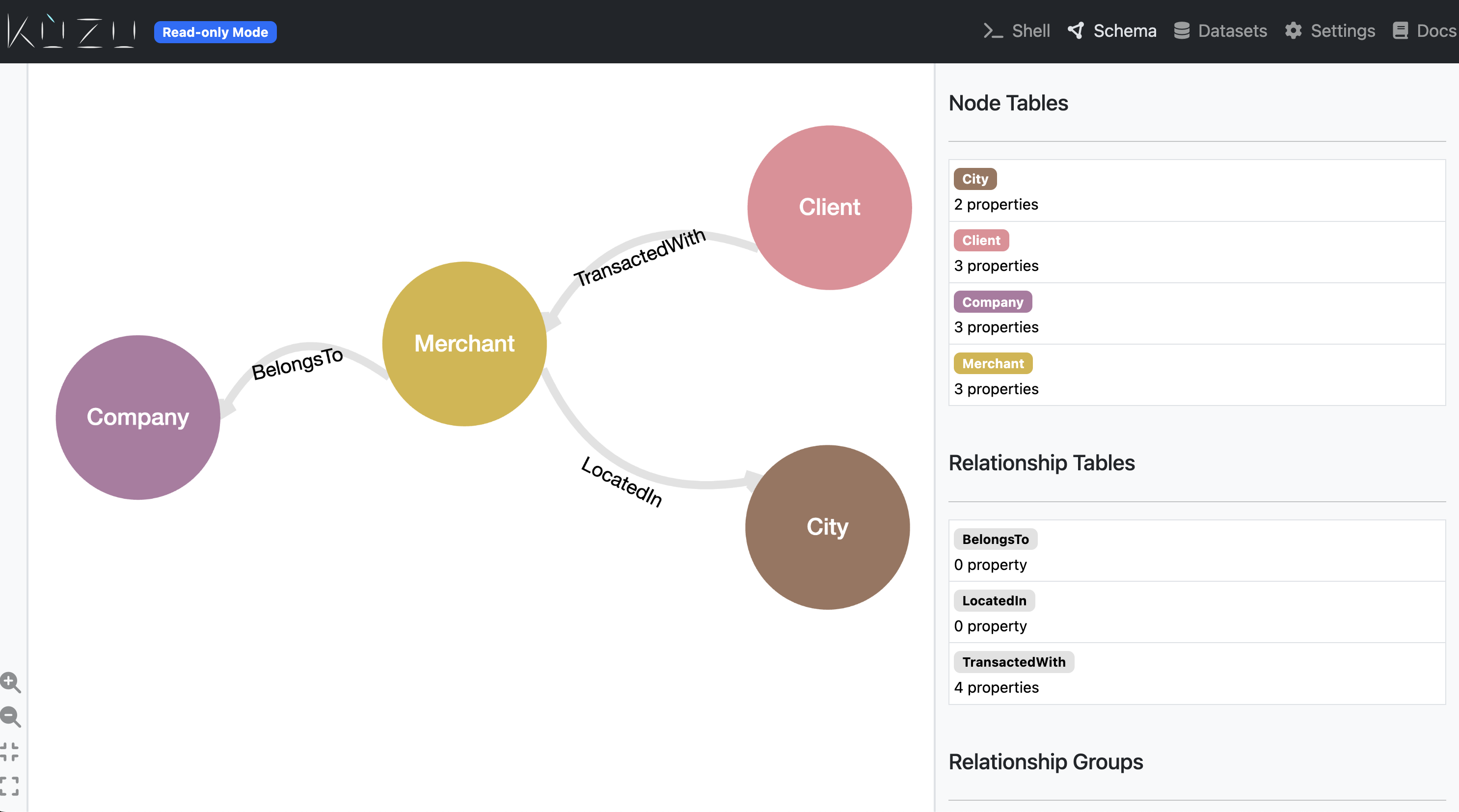
Exploratory data analysis
Once the data is loaded into Kuzu, it’s very simple to begin exploring the data using Cypher queries in one of three ways: i) using a Kuzu CLI shell, ii) using a Jupyter notebook, and iii) using the Kuzu Explorer UI. Because the goal of this exercise is to perform exploratory data analysis on the graph, we’ll Kuzu Explorer to visualize the graph and run Cypher queries.
MATCH (c:Client) RETURN COUNT(c) AS numClients| numClients |
|---|
| 100 |
MATCH (m:Merchant) RETURN COUNT(m) AS numMerchants| numMerchants |
|---|
| 100 |
MATCH (:Client)-[t:TransactedWith]->(:Merchant)
RETURN COUNT(t) AS numTransactions| numTransactions |
|---|
| 1100 |
The dataset contains 1,000 clients who made 1,100 transactions with 100 merchants. We can visualize the transactions with a particular merchant at a particular city and belonging to a particular company using the following query:
MATCH (c:Client)-[t:TransactedWith]->(m:Merchant)-[b:BelongsTo]->(co:Company)
MATCH (m)-[l:LocatedIn]->(ci:City {city: "Boston"})
WHERE co.company = "Panera Bread"
RETURN * LIMIT 25;The dataset contains two merchants belonging to Panera Bread in the city of Boston.
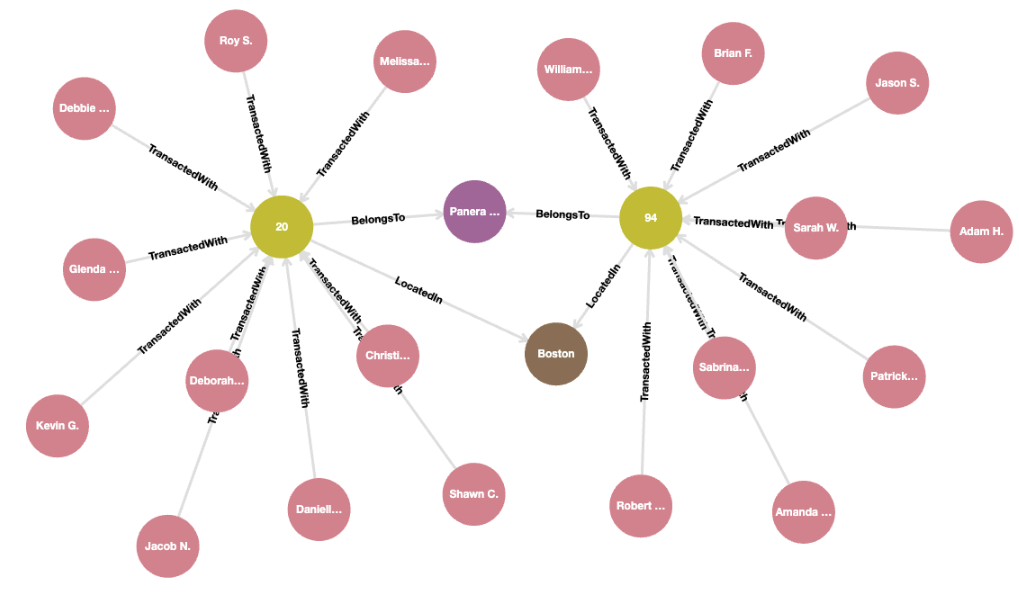
Study disputed transactions
The dataset becomes more interesting when we begin studying disputed
transactions. Not all disputed transactions are fraudulent, and so a simple aggregation query won’t
reveal many insights. We can begin by isolating only the vicinity of the disputed transactions of the
graph by specifying the boolean relationship property
is_disputed and then adding a subsequent MATCH statement to find the other merchants with whom
clients reported disputed transactions.
MATCH (c:Client)-[t:TransactedWith]->(m:Merchant)
MATCH (c)-[t2:TransactedWith]->(m2:Merchant)
WHERE t.is_disputed = true
RETURN * LIMIT 25;When running this query in Kuzu Explorer, we can customize the edge properties displayed in the graph visualization. In
the following image, we mark the TransactedWith edges with the boolean value of the is_disputed
property from the data. Only a small fraction of these transactions have the is_disputed property
marked as true.
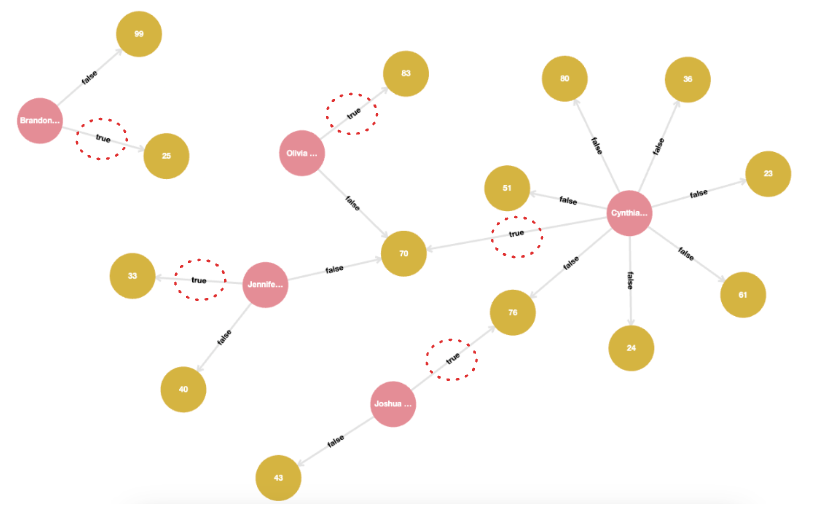
It can be seen that certain clients interacted with multiple merchants, some of which form a cluster. In other cases, nodes in the vicinity of a disputed transaction have no common paths with the larger graph, resulting in a disjoint subgraph. Fraud is less likely in the latter case, because a fraudster would likely have interacted with multiple clients that are part of a cluster sharing common merchants.
The list of client names who reported disputed transactions can be listed as follows:
MATCH (c:Client)-[t:TransactedWith]->(m:Merchant)
WHERE t.is_disputed = true
RETURN c.name AS name, t.timestamp AS transactionTime;| name | transactionTime |
|---|---|
| Joshua T. | 2023-11-21T16:54:30Z |
| Jennifer Y. | 2023-12-24T17:39:33Z |
| Brandon T. | 2023-08-04T18:21:27Z |
| Cynthia J. | 2023-12-24T02:49:31Z |
| Olivia C. | 2023-12-27T04:23:04Z |
Depending on the dataset, the time stamps of the disputed transactions in comparison to the timestamp of the transaction itself, could yield additional insights. The power of a graph structure is that it allows us to isolate substructures of interest based on the connected nature of the data.
The aim of the next query is to find the city in which the most disputed transactions occurred, and also to which companies the merchants processing these transactions belonged to.
MATCH (c:Client)-[t:TransactedWith]->(:Merchant)
WHERE t.is_disputed = true
WITH c
MATCH (c)-[t2:TransactedWith*..2]->(m:Merchant)-[:BelongsTo]->(co:Company)
WITH c, m, co
MATCH (m)-[:LocatedIn]->(ci:City)
RETURN
m.merchant_id AS merchantID,
ci.city AS city,
co.company AS company,
COLLECT(c.name) AS clients,
COUNT(c) AS counts
ORDER BY counts DESC LIMIT 3;| merchantID | city | company | clients | counts |
|---|---|---|---|---|
| 70 | Boston | Walmart | ["Olivia C.","Jennifer Y.","Cynthia J."] | 3 |
| 76 | San Francisco | Panera Bread | ["Joshua T.","Cynthia J."] | 2 |
| 51 | Chicago | AT&T | ["Cynthia J.","Cynthia J."] | 2 |
It can be seen that the clients Olivia, Cynthia and Jennifer all reported disputed transactions in a particular merchant location in Boston that belongs to the company Walmart. The query above returned the names of the clients, but in a larger dataset it makes sense to return the number of clients instead.
When viewed visually, these results can be quite powerful. The following image shows result from above, as seen in Kuzu Explorer.
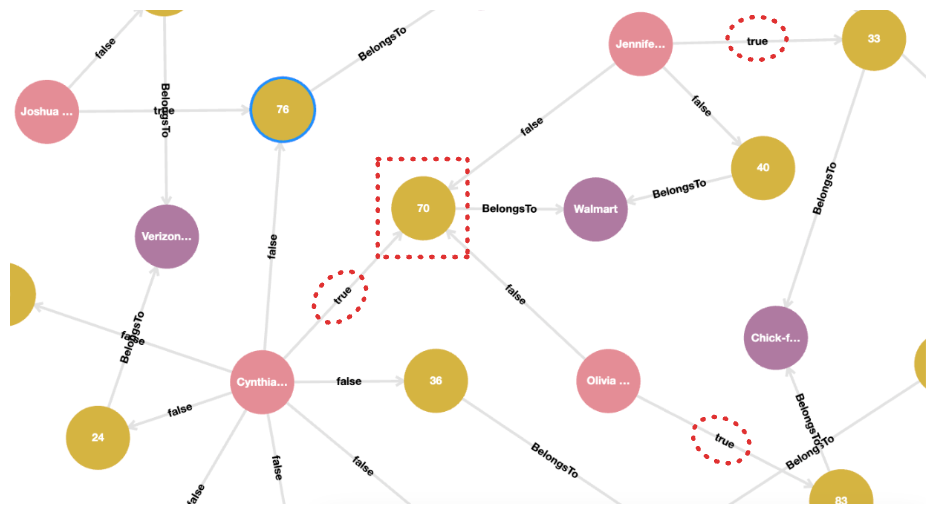
If we simply look at aggregates based on the company and merchant, we see that the clients Olivia, Jennifer and Cynthia from the previous query each reported disputed transactions in different merchant locations. However, they all had a common merchant in Boston (ID 70) belonging to Walmart, that they all made transactions within a plausible time window. This could indicate that this particular merchant, located in Boston, could be a source of fraud.
Graph algorithms
Kuzu is well-integrated with the PyData ecosystem, including PyTorch Geometric, Pandas, and NetworkX, a popular Python library for network analysis. Because Kuzu is an embedded graph database, it runs in-process with a Python application, so it’s simple to isolate a subgraph of interest via Cypher and convert it to a NetworkX directed graph (DiGraph) for further analysis.
Weakly connected components
A weakly connected component is a maximal subgraph in which there is a path between any two nodes, ignoring the direction of the edges. In the context of our subgraph of clients, merchants and the vicinity of disputed transactions, we can use this algorithm to isolate the disjoint subgraphs that we saw in the visualization earlier.
We first isolate the subgraph of clients, merchants and transactions in the vicinity of disputed transactions as follows:
import kuzu
import networkx as nx
db = kuzu.Database("./transaction_db")
conn = kuzu.Connection(db)
# Isolate the subgraph of interest
disputed_vicinity = conn.execute(
"""
MATCH (c1:Client)-[t1:TransactedWith]->(m:Merchant)<-[t2:TransactedWith]-(c2:Client)
WHERE t1.is_disputed = true
RETURN *;
"""
)
# Convert to networkx DiGraph
G1 = clients.get_as_networkx(directed=True)For every client that reported a disputed transaction, we isolate the subgraph of all the clients who interacted with these same merchants, as well as others. Running the weakly connected components algorithm will first inform us whether the vicinity of disputed transactions is a single connected component or not.
num_weakly_connected_components = nx.number_weakly_connected_components(G1)
print(num_weakly_connected_components)
# Output
2We obtain 2 weakly connected components, indicating that there are disjoint components in the disputed transactions subgraph.
To see which clients/merchants are in each weakly connected component, we can run the following:
weakly_connected_components = list(nx.weakly_connected_components(G2))
print(len(weakly_connected_components[0]))
print(len(weakly_connected_components[1]))
# Output
52
9The first cluster of clients and merchants contains 52 nodes, while the second cluster contains 9 nodes. This helps narrow down on a transaction subgraph that has a greater degree of connectivity.
Closeness centrality
Centrality algorithms are among the most commonly used algorithms in graph data science. At a high-level, centrality algorithms are used to identify “important” nodes - specifically, nodes that serve the role of connecting many other nodes in the graph. Suppose the owner of our transaction graph is an e-commerce company, and that the company wants to promote its “important merchants” to attract more customers to its network. Centrality metrics, similar to the popular PageRank metric, are concrete ways to order nodes in terms of “importance”.
Closeness centrality2 measures how close a node n is to all other nodes by calculating the
average of the shortest path length from n to every other node in the graph. For this example,
we will first isolate the full subgraph of all clients, merchants and transactions, not
just those in the vicinity of disputed transactions.
subgraph = conn.execute(
"""
MATCH (c:Client)-[t:TransactedWith]->(m:Merchant)
RETURN *;
"""
)
# Convert to networkx DiGraph
G2 = subgraph.get_as_networkx(directed=True)
closeness_centrality_result = list(nx.closeness_centrality(G1).items())
closeness_centrality_result.sort(key=lambda x: x[1], reverse=True)
print(closeness_centrality_result[:5])The top 5 nodes with the highest closeness centrality are shown below:
[('Merchant_35', 0.028),
('Merchant_56', 0.02666666666666667),
('Merchant_38', 0.025333333333333333),
('Merchant_66', 0.025333333333333333),
('Merchant_96', 0.024)]The scores indicate that the merchant with ID 35 is the most central node in the subgraph, i.e., it’s on average the closest to other nodes in the graph as a lot of paths go through it. Pandas makes this process very convenient.
import pandas as pd
df = pd.DataFrame(closeness_centrality_result, columns=["node_id", "closeness_centrality"])
df = df[df["node_id"].str.startswith("Merchant_")]
df["node_id"] = df["node_id"].str.replace("Merchant_", "").astype(int)
df = df.sort_values(by="closeness_centrality", ascending=False).reset_index(drop=True)
print(df.head(5))| node_id | closeness_centrality |
|---|---|
| 35 | 0.028000 |
| 56 | 0.026667 |
| 38 | 0.025333 |
| 66 | 0.025333 |
| 96 | 0.024000 |
Once we have the Pandas DataFrame, it’s trivial to write a function that can modify the existing
Merchant node table and add the closeness centrality scores back to the graph. Kuzu’s Python
API has a native scan feature that can directly read from Pandas DataFrames in a zero-copy manner.
Note that we first alter the original node table schema to add a new column for the closeness
centrality scores. We then use the LOAD FROM command to read the Pandas DataFrame into the graph.
try:
# Alter original node table schema to add degree centrality
conn.execute('ALTER TABLE Merchant ADD closeness_centrality DOUBLE DEFAULT 0.0')
except RuntimeError:
# If the column already exists, do nothing
pass
# Read degree centrality to graph
conn.execute(
"""
LOAD FROM df
MERGE (m:Merchant {merchant_id: node_id})
ON MATCH SET m.closeness_centrality = closeness_centrality
RETURN *;
"""
)Applying a similar process to the client nodes (via other centrality algorithms like degree centrality) can help us use these scores in downstream machine learning models, or to inform further decisions.
Conclusions
Hopefully, this post has given you a good idea of how to use Kuzu to effectively model and analyze your data via a combination of Cypher and graph algorithms. It’s worth keeping in mind that Graph data science, just like conventional data science, is an iterative process. The ability to think of structured data (in tables) as graphs helps us rapidly isolate interesting subsets of the data, run graph algorithms and visualize substructures, making these powerful tools in the data scientist’s toolkit.
Kuzu’s in-process architecture makes it very friendly towards these sorts of workflows without the data scientist having to worry about servers or managing infrastructure. Data can be conveniently read into Kuzu from a variety of sources, including relational databases, CSV or parquet files, or DataFrames. Future versions of Kuzu will support more convenience features, such as the ability to natively scan PostgreSQL tables, as well as native support for Arrow tables.
In summary, the interoperability of an embedded graph database with popular Python libraries like NetworkX and Pandas makes Kuzu a powerful tool for graph data science. If you have data of a similar nature in the form of relational tables, we highly recommend you to think about whether your use case can benefit from graph data models. If so, give Kuzu a try and reach out to us on Discord with your experiences and feedback!
Code
The code to reproduce the workflow shown in this post can be found in the graphdb-demo repository. It uses Kuzu’s Python API, but you are welcome to use the client API of your choice.
Further reading
Footnotes
-
Graph Powered Machine Learning, Ch. 2, By Alessandro Negro, Manning Publications, 2021. ↩
-
When is the Closeness Centrality Algorithm best applied? [blog post] (https://www.graphable.ai/blog/closeness-centrality-algorithm/), By Fatima Rubio, Graphable ↩


